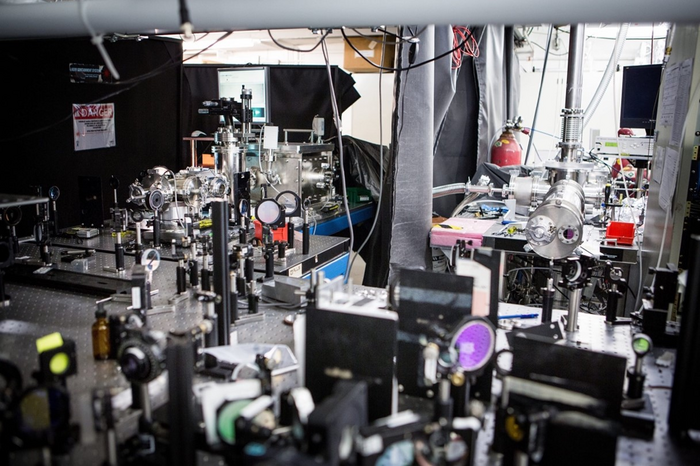Explaining dark autoionizing states could be beneficial to enhance the extreme ultraviolet laser power.
 An international research team led by Professors Tsuneyuki Ozaki and François Légaré at the Institut national de la recherche scientifique (INRS) in Canada, has developed a unique method to enhance the power of a laser source emitting extreme ultraviolet light pulses. Image Credit: Institut National De La Recherche Scientifique.
An international research team led by Professors Tsuneyuki Ozaki and François Légaré at the Institut national de la recherche scientifique (INRS) in Canada, has developed a unique method to enhance the power of a laser source emitting extreme ultraviolet light pulses. Image Credit: Institut National De La Recherche Scientifique.
A research group found a new optical phenomenon with dark autoionizing states, thereby improving the power of an extreme-ultraviolet laser.
An international research group headed by Professors Tsuneyuki Ozaki and François Légaré at the Institut national de la recherche scientifique (INRS), has come up with a special technique to improve the power of a laser source emitting extreme ultraviolet light pulses.
The fundamental mechanism of the newly noted phenomenon includes the special role of dark-autoionizing states via coupling with other pertinent electronic states.
As a result of this work, the team could learn about the ultrafast dynamics of a single dark autoionizing state at the femtosecond timescale. Earlier, this was impossible due to its inability to suffer single-photon absorption or emission, integrated with the ultrashort lifetime of such states.
The study outcomes enable the generation of ultrafast extreme ultraviolet light appropriate for advanced ultrafast science applications like photoemission electron microscopy and angle-resolved photoemission spectroscopy.
The study has been reported in the Physical Review Letters journal.
This work was done jointly with Professor Vasily Strelkov at the Prokhorov General Physics Institute of the Russian Academy of Sciences, Russia, and Research Assistant Professor Muhammad Ashiq Fareed at the University of Nebraska-Lincoln, USA.
Unraveling the Mysteries of the Dark-Autoionizing States
In their laboratories at the Énergie Matériaux Télécommunications Research Center, Professors Tsuneyuki Ozaki and François Légaré, along with Ph.D. student Mangaljit Singh, have been using unique kinds of electronic states, called dark-autoionizing states. Their study was completed by making use of high-order harmonic generation, an optical phenomenon untraditional to laser physics.
The newly published results are a step forward not only in understanding the behavior of dark autoionizing states under intense ultrafast laser-matter interactions, but also in bringing intense extreme-ultraviolet laser sources from large-scale synchrotron and free-electron laser facilities to the moderate-sized laser laboratories.
Mangaljit Singh, Study First Author and PhD Student, Institut national de la recherche scientifique
Several limitations enforced by the basics of laser physics limit most of the lasers utilized in communications, medicine, or industry. Similarly, they function only in the ultraviolet, visible (from violet to red), or invisible near and mid-infrared wavelength range.
But several advanced scientific applications need lasers to function at shorter wavelengths in the extreme ultraviolet range. The advanced systems make use of primary laser sources that are commercially available for high-order harmonic generation from noble gases to come up with secondary sources of coherent extreme ultraviolet light.
In this study performed, rather than noble gases, Singh and collaborators made use of a laser-ablated plume (obtained from the solid material’s laser ablation) for the high-order harmonic generation in sync with the special reaction of dark-autoionizing states.
They discovered that under some resonance conditions controlled by the electronic structure and primary laser parameters of the atomic and ionic species in the laser-ablated plume, the conversion efficiency, and thus the power of the extreme ultraviolet laser source, has been improved by over ten times.
This suggests that the same extreme ultraviolet power could be obtained with the help of a primary laser with power that is one-tenth of the power needed for a typical noble gas.
Besides offering an intense extreme ultraviolet light source, this study also displays for the first time the outlook of learning the dynamics of dark autoionizing states at the femtosecond timescale with the help of the high harmonic spectroscopy technique. Such dark states could be the foundation of various quantum technologies, particularly in enhancing the performance of quantum computation.
The experiments were carried out at the Advanced Laser Light Source (ALLS) laboratory at the INRS, a special laser-based infrastructure offering a coherent rainbow of light and cutting-edge end-stations to its users.
ALLS is part of LaserNetUS, a consortium of high-power laser facilities around North America that is progressing the frontiers of laser-science research.
Journal Reference:
Singh, M., et al. (2023) Ultrafast Resonant State Formation by the Coupling of Rydberg and Dark Autoionizing States. Physical Review Letters. doi.org/10.1103/PhysRevLett.130.073201.